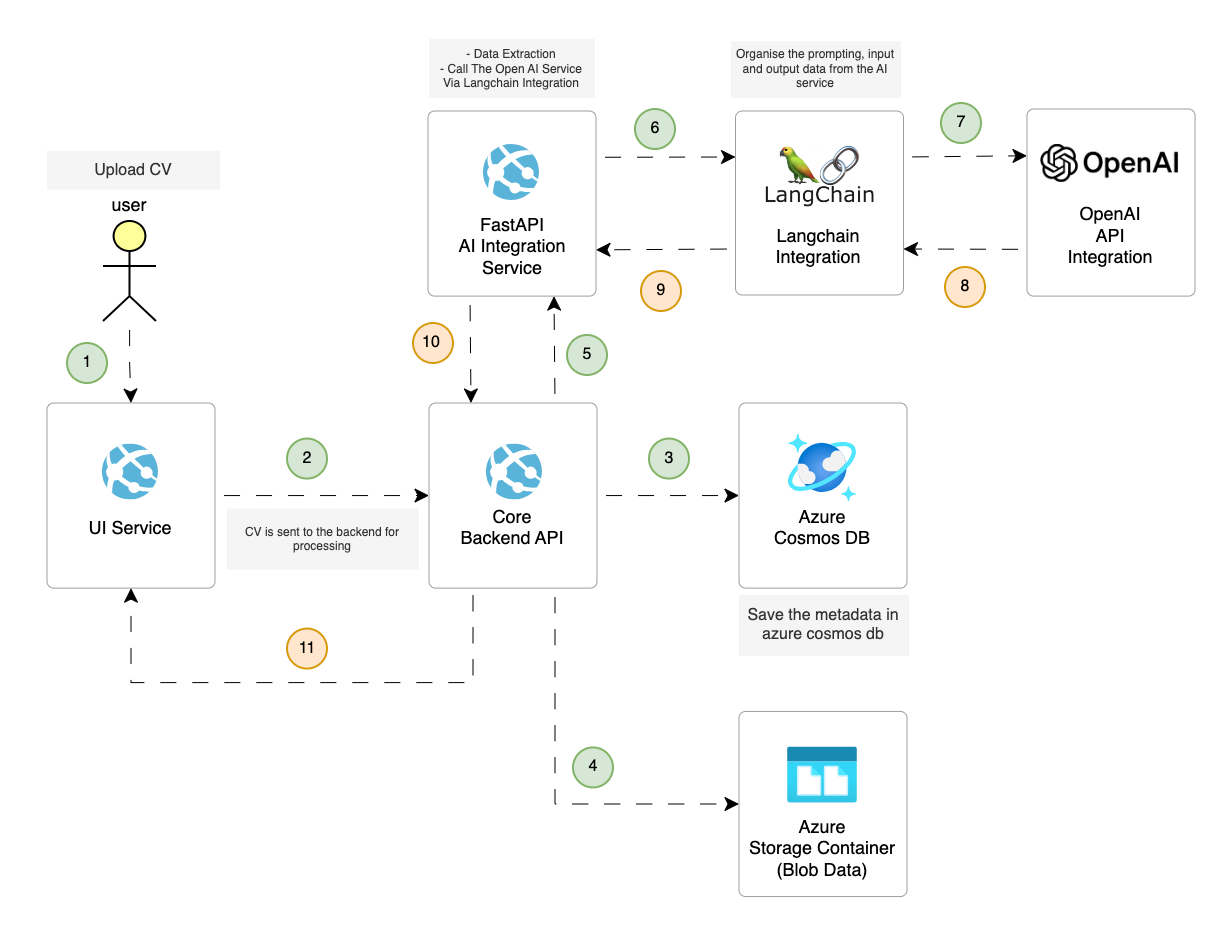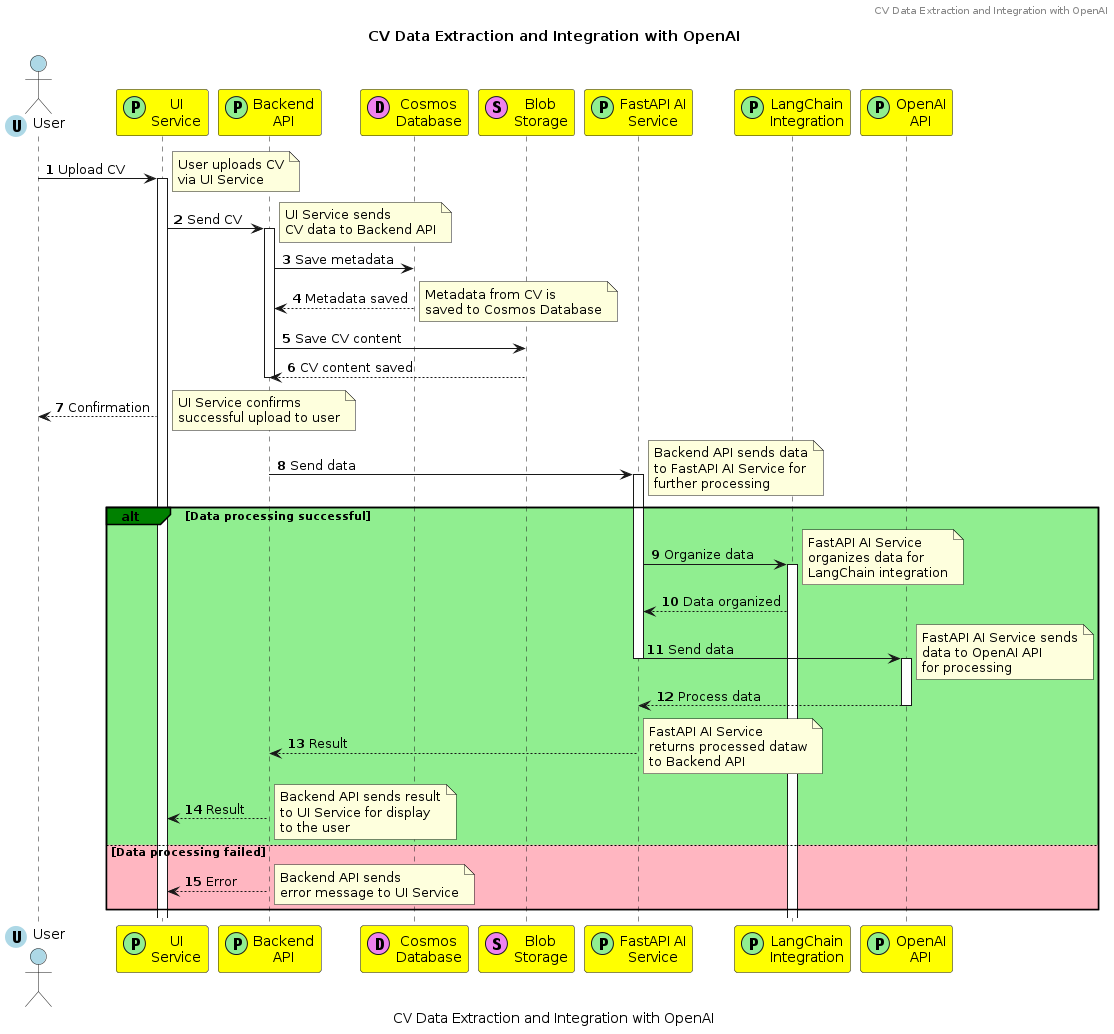AI-Driven CV Optimisation
A Comprehensive Workflow for Personalised Resume Enhancement

Table of Contents
- Introduction
- Project Overview
- Objectives and Goals
- Workflow Overview
- Technical Architecture
- Results and Outcomes
- Challenges and Solutions
- Conclusion
- Future Improvements
Introduction
Applying AI to our job application workflow has transformed how we approach job applications and hiring processes. With improved AI technology, individuals can tailor their CVs to specific job requirements, increasing their chances of securing their desired job. In this case study, we look at a project where a customer asked us to create a full process for an AI-powered CV optimisation tool.
Project Overview
Our client wanted to create a service that would let customers upload their CVs and have them changed into optimised versions targeted to certain job descriptions. This procedure necessitated integration with complex AI models, data extraction and storage management, and a seamless user experience.
Objectives and Goals
The main aims and goals for this initiative were:
- Data Extraction: Efficiently extract data from users' CVs for optimisation.
- AI Integration: Use OpenAI and LangChain to change resumes depending on specific job descriptions.
- Storage Management: Using Azure Storage solutions, you can securely and efficiently store CV data and metadata.
- User Experience: Make it easy for users to upload, customise, and download their CVs.

Workflow Overview
User Interaction
- User Uploads CV: Users upload their CVs via an intuitive user interface.
- Processing: The UI service sends the uploaded CV to the backend for processing.
Backend Processing
- CV Processing: The core backend API extracts data from the CV and prepares it for storage and AI processing.
- Data Routing: The backend service sends the CV data to the appropriate storage and AI services.
Storage Management
- Data Storage: CV data is stored in an Azure Storage Container (Blob Data).
- Metadata Storage: Metadata about the CV is saved in an Azure Cosmos DB.
AI Integration
- AI Request: The backend service calls the FastAPI service with the CV link and job description details.
- Data Extraction: FastAPI extracts data from the CV and crafts a structured prompt for OpenAI.
- OpenAI Processing: OpenAI uses the prompt to generate an optimized CV based on the provided job description.
- CV Generation: The generated CV data is returned to the backend service, which converts it into a PDF.
Technical Architecture
The project’s technical architecture consists of several key components:
- Frontend Interface: A user-friendly platform for users to upload and interact with their CVs.
- Backend API: core backend services that process CV data and interact with other services.
- Azure Storage Solutions: Secure storage for CV data and metadata in Azure Blob and Cosmos DB.
- FastAPI Service: Handles the AI processing with OpenAI, using LangChain for structured prompting.
- OpenAI Integration: Utilizes OpenAI's models to generate optimised CVs.

Results and Outcomes
The successful implementation of this AI-powered CV optimisation tool led to several notable outcomes:
- Improved User Experience: Users enjoyed a seamless and efficient process for uploading and customising their CVs.
- Enhanced CV Quality: The optimised CVs were tailored to specific job descriptions, increasing users’ chances of success.
- Secure Data Management: Azure storage solutions provide robust and secure data management.
- Positive Client Feedback: The client was highly satisfied with the project's outcomes, meeting their goals and expectations.

Challenges and Solutions
Throughout the project, we encountered and addressed several challenges:
- Data Extraction Complexity: We used advanced parsing techniques to accurately extract data from various CV formats.
- Prompt Engineering: Careful crafting of prompts using LangChain and OpenAI models ensured optimal CV customisation.
- Performance Optimisation: Optimising the workflow and services for speed and efficiency improved the overall user experience.
Conclusion
This case study showcases the successful implementation of an AI-powered CV optimisation tool. By leveraging advanced AI models and efficient data storage, we were able to provide a valuable service that greatly improved the quality of users' CVs and their job application prospects.
Future Improvements
To further enhance the project, future improvements could include:
- Multi-language Support: expanding support for multiple languages to cater to a broader user base.
- Enhanced User Analytics: Providing users with insights into the effectiveness of their CVs and potential areas of improvement.
- AI Model Updates: Continuously updating and fine-tuning AI models to maintain high-quality CV customisation.





